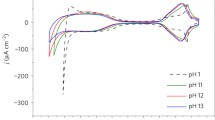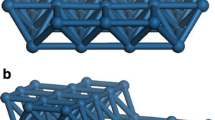Abstract
In the mid 1960th–early 1970th, A. Frumkin and O. Petrii investigated the adsorption of hydrogen at a platinized platinum electrode surface performing measurement of a change in the hydronium ion concentration when the large surface area electrode was immersed into an electrolyte solution at the fixed potentials in the hydrogen adsorption region under equilibrium conditions. The depletion (or increase) of the hydronium ions in the electrolyte bulk corresponded to the amount of hydrogen ions adsorbed at the electrode surface. They derived an equation relating the amounts of adsorbed hydrogen (atoms and ions) to the change of surface energy. A several decades later Guelph–Alicante team employed the Gibbs–Duhem equation to determine the amount of hydrogen atoms adsorbed at a small Pt single crystal electrode from the measurement of the total charge at the Pt surface. This paper compares the thermodynamic basis of the two types of measurements and demonstrates that despite differences between the nature of the two experiments their thermodynamic foundations are equivalent.
Similar content being viewed by others
Notes
From the viewpoint of thermodynamics, the final result of transformations of Eq. (13) will not depend on whether the metal surface charge is the sum of positive charges on Pt surface atoms (these atoms can have different charges, not only +1) and negative electron charges or this charge of the metal surface is defined only by the excess or deficit of electron charges in the absence of charges on Pt atoms. It should be added, as well, that the definition of the free charge as the difference between Gibbs excesses of Pt+ and electrons is given for historical reason, because it is this approach that was used by Parsons and Devanathan for the definition of free charge in their original paper [14] derived for mercury electrode.
It should be noted that the difference between the physical meaning of Γ values involved in Eqs. (1)–(4) and (9) and corresponding to the Frumkin and Petrii approach to the description of the interface under consideration and the similarly denoted values in Eq. (18) used in the approach proposed by the Guelph-Alicante team stems from the fact that the former authors used the chemical potentials of adsorbed species as the intensive parameters in the thermodynamic Gibbs equation and the latter authors used the electrochemical potentials as such parameters. However, both approaches lead to the correct Eq. (11) that describes the interface of Pt electrode with solutions of constant ionic strength or solutions with the excess of supporting electrolyte.
REFERENCES
Frumkin, A.N. and Petrii, O.A., Potentials of zero total and zero free charge on platinum group metals, Electrochim. Acta, 1975, vol. 20, p. 347.
Frumkin, A., Balashova, N., and Kazarinov, V., Some aspects of the thermodynamics of the platinum hydrogen electrode, J. Electrochem. Soc., 1966, vol. 113, p. 1011.
Frumkin, A., Petry, O., and Damaskin, B., The notion of the electrode charge and the Lippmann equation, J. Electroanal. Chem., 1970, vol. 27, p. 81.
Frumkin, A., Petrii, O., and Marvet, R., The dependence of the double-layer charge on the platinum hydrogen electrode surface upon potential, J. Electroanal. Chem., 1966, vol. 12, p. 504.
Savich, W., Sun, S.-G., Lipkowski, J., and Wieckowski, A., Determination of the sum of Gibbs excesses of sulfate and bisulfate adsorbed on Pt(111) electrode surface using chronocoulonometry and thermodynamic of the perfectly polarized electrode, J. Electroanal. Chem., 1995, vol. 388, p. 233.
Li, N. and Lipkowski, J., Chronocoulometric studies of chloride adsorption at the Pt(111) electrode surface, J. Electroanal. Chem., 2000, vol. 491, p. 95.
Herrero, E., Mostany, J., Feliu, J.M., and Lipkowski, J., Thermodynamic studies of anion adsorption at the Pt(111) electrode surface in sulfuric acid solutions, J. Electroanal. Chem., 2002, vol. 534, p. 79.
Mostany, J., Herrero, E., Feliu, J.M., and Lipkowski, J., Thermodynamic studies of anion adsorption at stepped platinum(hkl) electrode surfaces in sulfuric acid solutions, J. Phys. Chem. B, 2002, vol. 106, p. 12787.
Mostany, J., Herrero, E., Feliu, J.M., and Lipkowski, J., Determination of the Gibbs excess of H and OH adsorbed at a Pt(111) electrode surface using a thermodynamic method, J. Electroanal. Chem., 2003, vol. 558, p. 19.
Garcia, N., Clement, V., Feliu, J., and Lipkowski, J., Thermodynamic studies of chloride adsorption at the Pt(111) electrode surface from 0.1 M HClO4 solution, J. Electroanal. Chem., 2005, vol. 576, p. 33.
Garcia-Araez, N., Climent, V., Herrero, E., Feliu, J.M., and Lipkowski, J., Determination of the Gibbs excess of H adsorbed at a Pt(111) electrode surface in the presence of co-adsorbed chloride, J. Electroanal. Chem., 2005, vol. 582, p. 76.
Garcia-Araez, N., Climent, V., Herrero, E., Feliu, J.M., and Lipkowski, J., Thermodynamic approach to the double layer capacity of a Pt(111) electrode in perchloric acid solutions, Electrochim. Acta, 2006, vol. 51, p. 3787.
Trasatti, S. and Parsons, R., Interphases in systems of conducting phases: Recommendations 1985 Supersedes provisional version published 1983, J. Electroanal. Chem., 1986, vol. 205, p. 359.
Parsons, R. and Devanathan, M.A.V., A general thermodynamic theory of the ideal polarized electrode, Trans. Farad. Soc., 1953, vol. 49, p. 404.
Hurwitz, H.D., Direct determination of the surface excess of specifically adsorbed ions on mercury, J. Electroanal. Chem., 1965, vol. 10, p. 35.
Dutkiewicz, E. and Parsons, R., The adsorption of iodide ion from aqueous KI + KF of constant ionic strength, J. Electroanal. Chem., 1966, vol. 11, p. 100.
Author information
Authors and Affiliations
Corresponding authors
Ethics declarations
The authors declare that they have no conflicts of interest.
Additional information
A tribute to outstanding electrochemist Oleg Aleksandrovich Petrii (1937–2021).
Rights and permissions
About this article
Cite this article
Safonov, V.A., Lipkowski, J. On the Thermodynamics of Hydrogen Adsorption at Pt Electrodes. Russ J Electrochem 58, 891–895 (2022). https://doi.org/10.1134/S1023193522100111
Received:
Revised:
Accepted:
Published:
Issue Date:
DOI: https://doi.org/10.1134/S1023193522100111




